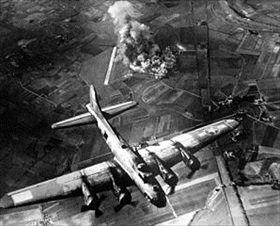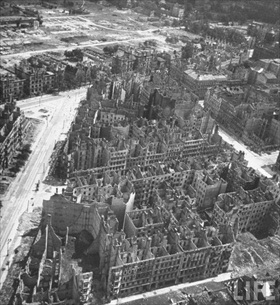MASSIVE AIR RAID ON REICH CAPITAL
Berlin, Germany · March 3, 1945
Round-the-clock bombing operations against Germany began on March 3, 1944, with a U.S. 800‑plane daylight raid that dropped 2,000 tons of bombs on Berlin. On this date in 1945 American bombers mounted a daylight raid on Berlin that left 3,000 people dead and 100,000 homeless. Luftwaffe bombers retaliated, attacking Britain for the first time in seven months. Two weeks later 1,250 Allied bombers made the heaviest daylight raid of the war on Berlin, dropping 3,000 tons of bombs, while fighting off a swarm of Me 262 German jets, which made their combat appearance for the first time. That same day Frankfurt am Main was attacked from the air and 1,000 people were killed. The last American raid on Berlin occurred on April 10, 1945, when 1,232 B‑17 Flying Fortresses and B‑24 Liberators beat off the largest jet effort of the war: 30 out of 50 Me 262s were shot down.
The daily raids on Adolf Hitler’s capital, begun in February 1945, were increased during the next two months (42,000 sorties between March 21 and 24 mainly on Berlin) until they turned into an almost incessant rain of bombs by U.S., British, and now Soviet air forces. Despite the bombing, 50,000 German refugees sought safety in Berlin each day in February, fleeing westward in advance of the Red Army as it swept through the Baltic states, East Prussia, and Poland.
It can be said that the carpet bombing of German cities reached its height once the war against the Third Reich had essentially been won at the end of 1944. Between January 1945 and May, in a bid to disrupt rail and river transportation networks and put more strain on Germany’s dwindling manpower and fuel resources, RAF Bomber Command dropped 191,540 tons of ordnance on Germany to the U.S. Eighth Air Forces’ 188,573 tons. During the European air war, a total of 2,770,540 tons of bombs were dropped by the Western Allies. After the war the U.S. Strategic Bombing Survey estimated that a minimum of 305,000 people were killed in German cities alone due to bombing and estimated a minimum of 780,000 wounded. Roughly 7,500,000 German civilians were rendered homeless. The bombing campaign cost 160,000 Allied airmen their lives.
![]()
The Allied Air Campaign Over Germany, 1943–1945
 |  |
Left: One of 100 B-17s dropping ordinance on Focke-Wulf’s 100-acre aircraft manufacturing plant at Marienburg (today’s Malbork in Northern Poland) on October 9, 1943.
![]()
Right: Thousands of unidentified victims of the February 1945 bombing of Dresden were stacked in layers over wood and burned in the Altmarkt (“Old Market”) square, once the site of flower markets. The daily cremation pyres disposed of 500 corpses a day. SS men who had run the Treblinka extermination camp in Eastern Poland, liberated by the Red Army on August 16, 1944, supervised workers cremating the bodies and carting off the fine ash that covered the Altmarkt’s cobblestones.
 |  |
Left: Operation Gomorrah, the 8‑day and 7‑night Anglo-American air attack on Hamburg beginning in late July 1943, killed 42,600 civilians, wounded 37,000, and practically destroyed the North German city on the Elbe River. The Allies’ devastating response to the Luftwaffe’s bombing of the British capital, London, between September 1940 and May 1941 (Blitz) caused one million civilians to evacuate Hamburg. Industrial losses were so severe that the city never recovered to full production.
![]()
Right: Relatives search through rows of victims of an Allied bombing on Berlin, September 23, 1944. Estimates of the number of dead in Berlin from all air raids range from 20,000 to 50,000, with the lower figure more likely. The relatively low figure is partly a testament to the capital’s superior air defenses and shelters.
 |  |
Left: An aerial photo of Berlin shows the legacy of destruction left by the war. By April 1945 Berlin had become a moonscape of ruined buildings and cratered streets.
![]()
Right: Danish journalist Paul von Stemann remembered the end days of Berlin as a time of “dullness, anticipation, fear and continuous bombing. . . The war seemed perpetual. . . The flowers had gone, the books had been burnt, the pictures had been removed, the trees had been broken, there were no birds singing, no dogs barking, no children shrieking . . . there was no laughter and no giggling. . . [The sky] was often effaced by the stinking and greasy carpets of voluminous black smoke.” Quoted in Moorhouse, Berlin at War, pp. 346–47.
1944 Newsreel Clips: Bombers over Berlin, Returning Allied POWs, Australian Veterans Parade in Sydney, German POWs in U.S., Italian Refugees in Southern Italy, and Allied Forces in England Get Ready for Normandy Invasion
![]()

 History buffs, there is good news! The Daily Chronicles of World War II is now available as an ebook for $4.99 on Amazon.com. Containing a year’s worth of dated entries from this website, the ebook brings the story of this tumultuous era to life in a compelling, authoritative, and succinct manner. Featuring inventive navigation aids, the ebook enables readers to instantly move forward or backward by month and date to different dated entries. Simple and elegant! Click
History buffs, there is good news! The Daily Chronicles of World War II is now available as an ebook for $4.99 on Amazon.com. Containing a year’s worth of dated entries from this website, the ebook brings the story of this tumultuous era to life in a compelling, authoritative, and succinct manner. Featuring inventive navigation aids, the ebook enables readers to instantly move forward or backward by month and date to different dated entries. Simple and elegant! Click 











